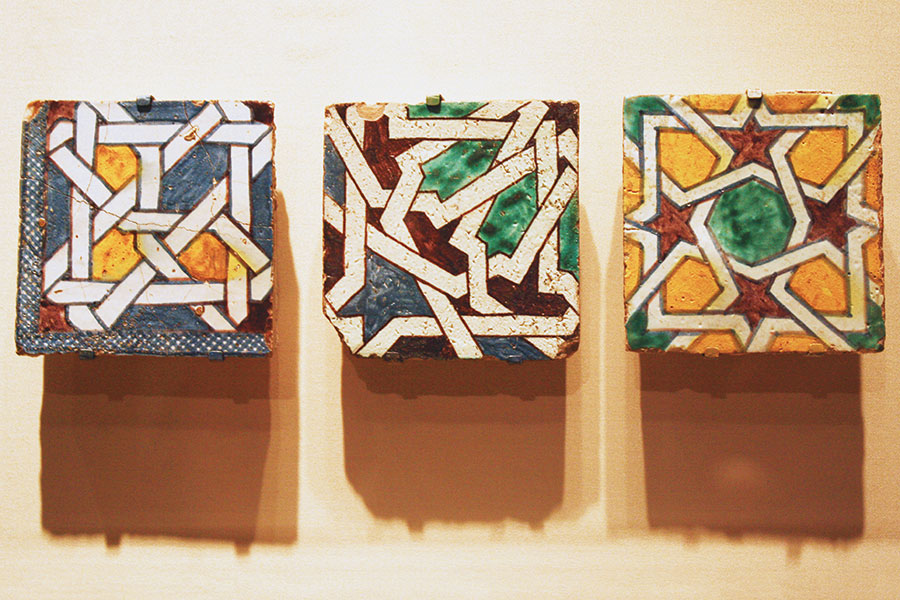
New Galleries for Islamic Art
Art Institute of Chicago
111 South Michigan Avenue
Ongoing Exhibition
After three years of closure, the Islamic Art wing at the Art Institute of Chicago has re-launched with dramatically redesigned permanent galleries. Rich earth toned walls and pointed archways nod to Middle Eastern interior architecture as visitors wander through 3,200 square feet of exhibits crossing continents and millennia.
“The space permits the display of many more objects than before, including oversized material not previously shown at all,” explained Daniel Walker, Chair and Christa C. Mayer Thurman Curator of Textiles and Curator of Islamic Art. “One space created by the addition of an arch wall encompasses a display of architectural elements, notably two examples of mosaic tile from 15th century Iran and an impressive group of 14th century wooden doors and carved beams from Morocco.”
On view in the first gallery, the never-before-exhibited architectural artifacts balance mass with magnetic tactility. By forgoing protective glass in select displays, visitors are welcome to have an intimately close look at ornately carved heavy timbers, flecked with paint. Intricate slate tiles from 18th century Mughal India are carved to make the brittle stone appear supple. The materiality sparks curiosity. Gallery-goers seemed to linger longer at these visceral masterworks than anywhere else in the exhibition.
Moroccan doors in the recently reopened Islamic galleries at the Art Institute of Chicago.
|
The soaring Moroccan doors and illuminated window grille panel in the front gallery inject momentum down the space as visitors progress into the primary exhibition hall. Chronologically, traditional display cases filled with artifacts serve as snapshots from distinct dynasties, across geographic hubs of Islam, from Spain to Indonesia.
These displays require some stamina. Many of the artifacts currently on view are petite designed objects and fragile works on paper. Some display cases currently identify that the installation is still in progress. The collection is planned to rotate periodically with loaned pieces, so perhaps this segment will evolve more than other areas. Since the artists’ precision is the focal point of many of the works, however, it is unfortunate that there is no opportunity to sit and investigate any of the fine details. The display hall invites more transient glances than mindful study.
A glowing central display helps to reinvigorate the main hall with a sense of playfulness. At the center of the room, a floor-to-ceiling wall wrap reproduces cerulean botanical Turkish tiles as though hundreds of tiles were installed along the wall. It is an impactful demonstration of the prominence of pattern in Islamic Art. Two of the authentic ceramic tiles from the 1560s are on view nearby, explaining that they once covered the brilliant mosques and palace walls of the Ottoman sultans. The cheery graphic pattern of the faux tile wall is Instagram heaven. It’s a rare moment of new media engagement in an otherwise conservative exhibition.
The final gallery room, despite superb artwork, feels like a bit of a missed chance for elevated discourse at the Art Institute. Showcasing several 20th century works, the gallery seeks to show the influences of Islamic visual culture on later generations of makers. The small gallery has such an ambitiously wide range of aesthetics, though, that the narrative gets murky.
The highlight of the back room is a bronze sculpture from Parviz Tanavoli’s well-known Heech (Nothing) series, on loan from New York University. Tanavoli, a groundbreaking Iranian sculptor, was a founding member of Iran’s influential Saqqakhaneh artistic movement of the 1960s. Heech is as contemporary and political as the Islamic Art exhibition dares to go.
With the re-opening of these galleries, the Art Institute has a poignant opportunity to become Chicago’s critical platform for modern and contemporary Islamic visual culture. There is, indeed, prominent wall text in the main gallery distinguishing the Islamic World as a culture from the active religion of Islam. However, as the exhibition culminates in the final room with a piece from over 40 years ago, it lacks a convincing emotional bridge to today’s viewer. This could have been resolved through improved contemporary storytelling and interactive content. The Field Museum’s current Vodou: Sacred Powers of Haiti exhibit, for example, directly sets out to dispel misconceptions about a cultural practice with an extroverted and frank relatability. Alternatively, this quiet back room could become a space for thoughtful introspection—the Islamic Art wing’s parallel to the Ando Gallery, the iconic sanctuary embedded in the Art Institute’s Japanese collection.
Undoubtedly, the re-opening of the Islamic Art galleries is a boon to Chicagoans. Architects with a fascination for handcrafted architectural details, unusual materials, or colorful patterns will delight in this world-class resource. As an excellent curatorial complement after exploring Islamic Art, the adjacent gallery has recently installed an outstanding early-to-mid 20th century European textile exhibit, Off the Bolt, which pattern fans and modern design lovers will decidedly enjoy. As new programming and visiting works maintain dynamism in the Islamic Art wing, the space promises to be increasingly valuable for knowledgeable, cross-cultural conversations in the city.